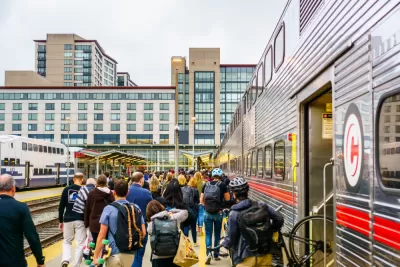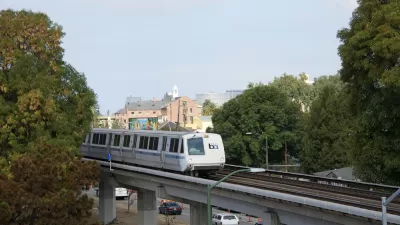Santa Clara, San Mateo, and San Francisco county voters could see a ballot measure to fund an ambitious Caltrain plan with a one-eighth cent sales tax, amounting to more than $100 million dollars per year.

A proposed measure supported last month by the SamTrans board of directors could afford Caltrain $108 million per year to increase its service frequency and purchase electrified trains if approved by Bay Area voters. Funding from a one-eighth cent sales tax would enable the rail line to serve thousands of more commuters and eventually extend service to downtown San Francisco.
Pending a two-thirds majority vote from Santa Clara, San Mateo, and San Francisco county boards of supervisors as well as VTA, the San Francisco Municipal Transportation Agency, and Caltrain’s board, county voters would decide on the measure in November.
"Funding from the tax measure would help Caltrain run 168 trains each weekday between San Jose and San Francisco by 2022, officials say, with trains arriving every 10 minutes during peak commute hours. Gilroy and southern Santa Clara County would see more frequent service as well," reports Nico Savidge. Caltrain's future plans could increase service to 200 trips per day.
Since the onset of the coronavirus pandemic, total daily trips were reduced from 92 to only 42. Now that Caltrain commuters are staying home, the agency has seen a reduction in its operating budget, 70 percent of which is funded by passenger fares. It remains to be seen how much of the $1.3 billion federal stimulus will be afforded to Caltrain.
FULL STORY: New tax for Caltrain? Measure this fall could fund trains every 10 minutes

Planetizen Federal Action Tracker
A weekly monitor of how Trump’s orders and actions are impacting planners and planning in America.

San Francisco's School District Spent $105M To Build Affordable Housing for Teachers — And That's Just the Beginning
SFUSD joins a growing list of school districts using their land holdings to address housing affordability challenges faced by their own employees.

The Tiny, Adorable $7,000 Car Turning Japan Onto EVs
The single seat Mibot charges from a regular plug as quickly as an iPad, and is about half the price of an average EV.

Seattle's Plan for Adopting Driverless Cars
Equity, safety, accessibility and affordability are front of mind as the city prepares for robotaxis and other autonomous vehicles.

As Trump Phases Out FEMA, Is It Time to Flee the Floodplains?
With less federal funding available for disaster relief efforts, the need to relocate at-risk communities is more urgent than ever.

With Protected Lanes, 460% More People Commute by Bike
For those needing more ammo, more data proving what we already knew is here.
Urban Design for Planners 1: Software Tools
This six-course series explores essential urban design concepts using open source software and equips planners with the tools they need to participate fully in the urban design process.
Planning for Universal Design
Learn the tools for implementing Universal Design in planning regulations.
Smith Gee Studio
City of Charlotte
City of Camden Redevelopment Agency
City of Astoria
Transportation Research & Education Center (TREC) at Portland State University
US High Speed Rail Association
City of Camden Redevelopment Agency
Municipality of Princeton (NJ)





























